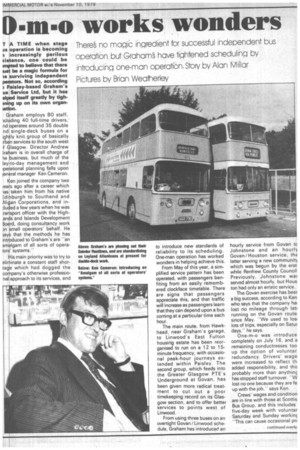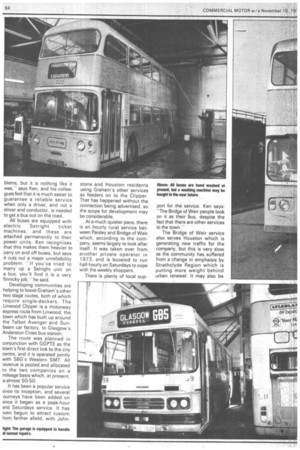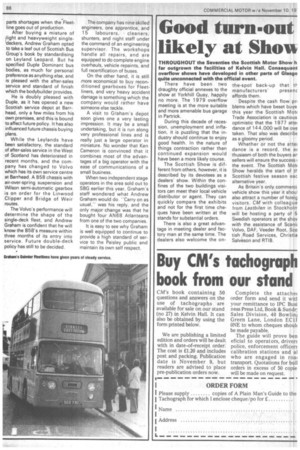• Immo works wonders
Page 85

Page 86

Page 87

Page 88

If you've noticed an error in this article please click here to report it so we can fix it.
There 's no magic ingredient for successful independent bus operation but Graham S have tightened scheduling by introducing one-man operatiOn. Story by Alan Millar Pictures by Brian Weatherley
TIME when stage as operation is becoming increasingly perilous Kis ence, one could be trnpted to believe that there lust be a magic formula for le surviving independent perators. Not so, according ) Paisley-based Graham's us Service Ltd, but it has Biped itself greatly by tighming up on its own organmotion.
raham employs 80 staff, cliding 40 full-time drivers,nd perates around 35 double ndl single-deck buses on a ghtly knit group of basically rban services to the south west Glasgow. Director Andrew iraham is in overall charge of tousiness, but much of the la0o-day management and iperational planning falls upon jeneral manager Ken Cameron.
Ken joined the company two rears ago after a career which as taken him from his native Edinburgh to Southend and Nigan Corporations, and in.:luded a few years when he was :ransport officer with the Highands and Islands Development 3oard, doing consultancy work Dn small operators' behalf. He says that the methods he has Introduced to Graham's are "an amalgam of all sorts of operators' systems."
His main priority was to try to eliminate a constant staff shortage which had dogged the Corpany's otherwise professional approach to its services, and to introduce new standards of reliability to its scheduling. One-man operation has worked wonders in helping achieve this.
From May of this year, a simplified service pattern has been operated, with passengers benfiting from an easily remembered clockface timetable. There are signs that passengers appreciate this, and that traffic will increase as passengers learn that they can depend upon a bus coming at a particular time each hour.
The main route, from Hawkhead, near Graham's garage, to Linwood's East Fulton housing estate has been reorganised to run on a 12 to 15minute frequency, with occasional peak-hour journeys extended within Paisley. The second group, which feeds into the Greater Glasgow PTE's Underground at Govan, has
been given more radical treatment to cut out a poor timekeeping record on its Glasgow.section, and to offer better services to points west of Linwood.
From using three buses on an overtight Govan /Linwood schedule, Graham has introduced an hourly service from Govan tc Johnstone and an hourly Govan/Houston service, thE latter serving a new community which was begun by the erst. while Renfrew County Council Previously, Johnstone wa served almost hourly, but Hous ton had only an erratic service.
The Govan exercise has beer a big success, according to Ken who says that the company ha: lost no mileage through lab running on the Govan route since May. "We used to losl lots of trips, especially on Satut days," he says.
One-m-o was introduce completely on July 16, and a remaining conductresses too up the option of voluntar redundancy. Drivers' wage were increased to reflect th added responsibility, and thi. probably more than anything has stopped staff turnover. "W lost no one because they are fe up with the job," says Ken.
Crews' wages and condition are in line with those at Scottis Bus Group, and this includes five-day week with voluntar Saturday and Sunday workinc "This can cause occasional prt blems, but it is nothing like it was," says Ken, and his colleagues feel that it is much easier to guarantee a reliable service when only a driver, and not a driver and conductor, is needed to get a bus out on the road.
All buses are equipped with electric Setright ticket machines, and these are attached permanently to their power units. Ken recognises that this makes them heavier to carry on and off buses, but says it cuts out a major unreliability problem. "If you've tried to marry up a Setright unit on a bus, you'll find it is a very finnicky job," he said.
Developing communities are helping to boost Graham's other two stage routes, both of which require single-deckers. The Linwood Clipper is a motorway express route from Linwood, the town which has built up around the Talbot Avenger and Sunbeam car factory, to Glasgow's Anderston Cross bus station.
The route was planned in conjunction with GGPTE as the town's first direct link to the city centre, and it is operated jointly with SBG's Western S MT. All revenue is pooled and allocated to the two companies on a mileage basis which, at present, Is almost 50-50.
It has been a popular service since its inception, and several ourneys have been added on ;ince it began as a peak-hour nd Saturdays service. It has )ven begun to attract custom from farther afield, with John
stone and Houston residents using Graham's other services as feeders on to the Clipper. That has happened without the connection being advertised, so the scope for development may be considerable.
At a much quieter pace, there is an hourly rural service between Paisley and Bridge of Weir which, according to the company, seems largely to look after itself. It was taken over from another private operator in 1973, and is boosted to run half-hourly on Saturdays to cope with the weekly shoppers.
There is plenty of local sup
port for the service. Ken says: "The Bridge of Weir people look on it as their bus, despite the fact that there are other services to the town."
The Bridge of Weir service also serves Houston which is generating new traffic for the company, but this is very slow as the community has suffered from a change in emphaisis by Strathclyde Region which is putting more weight behind urban renewal. It may also be difficult for Graham — or any other operator — to extend services there, as much depends upon private developers willingness to cater for public transport access.
It is in this connection that the company has most of its dealings with the PTE which acts as. a clearing house for observations sent through councillors and which gives good links to Strathclyde Region's roads department. When diversions to routes are in prospect, the PTE is able often to act as a referee and oil the wheels of local government.
Graham is a bus operator first and foremost, and does little private hire work at present. On the other hand, it is committed to school transport in Renfrewshire, carrying children to and from Bridge of Weir, Erskine, Elderslie, Linwood, Houston, and Paisley, and carries workers to the Talbot factory and the National Savings Bank in Glasgow. Having come to grips with its operational problems, Graham is prepared to make its service! better known to the Paisle public by issuing a timetablE leaflet through librariers anc other outlets. This incorporatef. a list of services operated, easil read timetables for routes anc sections of routes, and a stylise( map of the network.
The fleet had been temporarily inflated to 40 vehicles when visited Graham's in October, bu. this included several second hand buses which were beinc_ prepared for service. On a basi! of a 35-vehicle fleet, the corn pany runs about one millior miles every year, with eact vehicle doing just over 28,00( 'miles a year.
Standard double-decker a present is the Leyland Atlanteai AN68, of which eight are ownei alongside some older-typ, Atlanteans. They have give! very good service, according t Andrew Graham, who accept that their fuel consumption .inferior to that of the previou standard, the Daimler Fleetlin€ with Gardner engine.
But Fleetlines have suffere from gearbox failures for som years, and are to be phased at of service as new buses a bought. This is not just to avoi heavy expenditure sometimes as much as £.1,50 — on reconditioned gearboxe but it will also save the compar from being caught out by spa
continued overie Left: The rural Bridge of Weir service operated with such single deckers their Leyland Leopard with Our Dominant bus body.
parts shortages when the Fleetline goes out of production.
After buying a misture of Ilight and heavyweight single!deckers, Andrew Graham opted to take a leaf out of Scottish Bus Group's book by standardising on Leyland Leopard. But he specified Duple Dominant bus bodies, as much for personal preference as anything else, and is pleased with the after-sales service and standard of finish which the bodybuilder provides.
He is doubly pleased with Duple, as it has opened a new Scottish service depot at Barrhead, only a few miles from his own premises, and this is bound to affect future policy. It has also influenced future chassis buying plans.
While the Leylands have been satisfactory, the standard of after-sales service in the West of Scotland has deteriorated in recent months, and the company has changed to Volvo which has its own service centre at Barrhead. A 858 chassis with air-over-spring suspension and Wilson semi-automatic gearbox is on order for the Linwood Clipper and Bridge of Weir routes.
The Volvo's performance will determine the shape of the single-deck fleet, and Andrew Graham is confident that he will know the B58's measure within three months of its entry into service. Future double-deck policy has still to be decided. The company has nine skilled engineers, one apprentice, and 15 labourers, cleaners, shunters, and night staff under the command of an engineering supervisor. The workshops handle all repairs, and are equipped to do complete engine overhauls, vehicle repaints, and full recertification of buses.
On the other hand, it is still more economical to buy reconditioned gearboxes for Fleetliners, and very heavy accident damage is something which the company would rather have someone else tackle.
A visit to Graham's depot soon gives one a very lasting impression. It may be a small undertaking, but it is run along very professional lines and is really just a large operator in miniature. No wonder that Ken Cameron is convinced that it combines most of the advantages of a big operator with the ease of communications of a small business.
When two independent stage operators in the area sold out to SBG earlier this year, Graham's staff wondered what Andrew Graham would do. "Carry on as usual,'" was his reply, and the only major change was that he bought four AN68 Atlanteans from one of the two companies.
It is easy to see why Graham is well equipped to continue to provide a high standard of service to the Paisley public and maintain its own self respect.












































































































































































































































